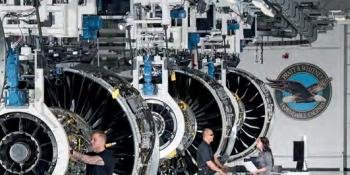Chris Kjelgaard provides a detailed technological description of the GE9X engine powering the Boeing 777X family
COMMERCIAL BOEING 777X
When GE Aviation’s new GE9X large-turbofan engine enters commercial service on the first Boeing 777-9 delivered to a customer, an event Boeing is slating for December 2019, it will be the largest turbofan powerplant ever to go into service.
Although as a 100,000lb-class-thrust (444.8kN) engine the GE9X by design won’t offer quite as much maximum take-off thrust as the GE90-115B and GE90-110B1 engines (which respectively power today’s 777-300ER and 777-200LR/777F airframes and are the most powerful turbofan engines in the world), it will have a fan diameter 6in (152mm) greater than that of those engines. In addition to its 134in (3.403m) fan diameter – the largest developed for any jet engine to date – the GE9X will have a corresponding fan-case diameter that also will be bigger than the 154.6in-wide (3.926mm) fan case of the two huge GE90 powerplants. Like its siblings, the GE9X will have an overall diameter greater than the fuselage diameter of the Boeing 737 family.
According to Ted Ingling, GE9X programme manager, the reason the GE9X won’t offer quite as much maximum take-off thrust as the 115,540lb (513.9kN) certificated for the GE90- 115B and the 110,760lb (492.7kN) certificated for the GE90-110B1 is that it won’t have to. He told AIR International: “That’s a testament to Boeing’s [777X design] and primarily the wing; they’ve done a marvellous job in getting the lift drag on the aircraft such that the engine thrust required to fly the bigger 9X-powered aircraft doesn’t have to be as high as for the 777-300ER, the GE-115B-powered plane.”
However, because it has a bigger fan and a larger-diameter fan case than the GE90-115B, the GE9X will be a little heavier at approximately 20,000lb (9,071kg) than the earlier engine, which weights 19,316lb (8,761.6kg) dry. That’s not to say that the GE9X won’t be as fuel efficient. In fact, GE’s major design criterion for the 777X engine was to make it 10% more fuel efficient than the predecessor 777-300ER powerplant, and for it to offer 5% lower specific fuel consumption (SFC) than any other engine in or about to enter service on any twin-aisle aircraft.
The GE9X fan module
GE Aviation expects to achieve that goal using a variety of new technologies, prime among them the improved capabilities that latest-generation computerised aerodynamics modelling offers for airflow design. In the GE9X, this, along with GE Aviation’s deep experience of using carbon-fibre composite materials to make three-dimensional airfoils, ha s resulted in the company being able to construct the engine’s massive fan using just 16 fan blades, compared with 22 in the GE90- 115B and 18 in the GEnx engine powering the Boeing 787 and 747-8, the GE9X’s direct forebear in design terms.
Ingling said: “The ability to use the solidity and aero shaping of the airfoils allowed us to get greater efficiency, thrust flow at speed and reduce the airfoil count. The airfoil count is a big deal for rotating parts, because on the fan blades we can grow the fan diameter to get airflow – bypass ratio is a big play for SFC and noise – but we can also pull the inner radius of the [fan air] flowpath inward, because on the disc that holds on to those blades the radius that encompasses the blade dovetails can come inward, because there are fewer [blade-seating] slots and fewer blades. So, we get a little bit of free real estate by reducing airfoil count relative to getting a bigger flowpath, and of course they are lighter and fewer to maintain.” The 16 huge blades allow the GE9X’s fan to ingest and propel 3,850lb (1,746kg) of air every second at maximum take-off power.

While each of the GE9X’s 16 highly 3D curved fan blades is made using, Ingling said, “the same [carbon-fibre] laminate lay-up technology we used on the original GE90, the GE90-115 and the GEnx”, another important innovation GE is introducing is to line each fan blade’s leading edge with steel, rather than titanium, which GE uses to line GE90 and GEnx fan blades. Ingling said: “One of the things you like on a [blade] airfoil is nice thin leading edges, and because steel has got the strength capability over titanium we were able to thin that leading edge to get even more performance. That goes into the aerodynamics to get higher efficiency and reduced airfoil count.”
However, at some locations elsewhere in the GE9X fan module GE has replaced metal with polymer matrix composite (PMC) material made of carbon-fibre composite. In addition to making the GE9X’s blade platforms – the spacers that sit between the fan blades – and its entire fan case from PMCs, for the first time GE has used PMC material to make the fan module’s structural outlet guide vanes (OGVs).
In the fan module, the OGVs connect the outer fan case’s aft ring to the inner fan hub as structural elements. They also fulfil another role. The OGVs are designed to straighten out the turbulent airflow propelled behind the fan by the blades before the flow enters the fan duct and then enters the low-pressure compressor booster, for the 10% of the air that flows axially into the engine’s core, because the GE9X is designed to produce a 9:1 bypass ratio to make it really quiet in operation.
Ingling said: “That’s the first time we have combined those two functions in a composite structure. We’ve had composite OGVs, but historically had [metal] structural struts or structural OGVs that go between those to carry that load. This is the first vehicle that expands the use of PMCs to fill in both of those elements.”
The GE9X’s booster and HPC
The GE9X’s three titanium-constructed booster stages are conventional in design. As with the GE90 and GEnx, GE has chosen to install dual-purpose variable bleed valves (VBVs) between the engine’s booster and high-pressure compressor (HPC) modules. In the earlier engines the VBVs, which open inward into the core airstream and bleed air from it into the bypass duct, serve to take the airflow load off the HPC, allowing the engine to spool up very quickly when needed, and to extract dust, sand and other debris particles from the core air.

Ingling said: “This engine has a very similar philosophy in using that geometry to extract dust and debris from the engine and it’s functional when the [VBV] doors are open, which is generally on the ground or very near the ground. It’s proven to be very effective in extracting particles that can be centrifuged, which are the ones that can erode compressor airfoils… keeping the hard stuff out of the engine is a big deal because that’s the stuff you can’t recover. When you erode the [compressor] airfoils, the only way to fix that is to disassemble and repair.”
While the GE9X’s booster is of conventional design and construction, its 11-stage HPC is the most advanced ever designed by GE for a commercial aero engine. Each of the HPC’s first five rotating stages is a single-piece blisk, reducing parts count greatly. The six subsequent HPC stages all use hundreds of individual blades, but as it travels through the HPC from front to back the advanced blade airfoils compress the core air by a factor of 27 before it enters the combustor. The blades on the hindmost HPC stage are only about 1in (25mm) high.
This 27:1 compression ratio gives the GE9X an overall pressure ratio (OPR, the ratio of the pressure of the air entering the combustor compared with the air entering the fan inlet) of 60:1, the highest OPR GE has ever achieved for a commercial engine and probably the highest of any commercial engine in or nearing service. The GE90-115B has an OPR of approximately 40:1 and the GEnx an OPR of about 50:1.
Because air heats up when it is compressed, the air flowing through the HPC’s rearmost stages is very hot. GE has constructed the very back GE9X HPC stages from powdered-metal nickel superalloy that Ingling said “we’ve been using in the turbines for years”.
Because the air entering the GE9X combustor is so, the engine’s third-generation twin-annular, pre-swirled, mixing (TAPS) combustor is, Ingling said: “running a little hotter than the GEnx”, its direct forebear.
Additively manufactured parts
Each of the 28 fuel nozzles in the engine’s combustor – for comparison, the CFM LEAP- 1A engine has 19 fuel nozzles – is additively manufactured, allowing GE to combine what would have been about 28 separate parts in a traditionally manufactured fuel nozzle into just one. In this regard, additive manufacturing is, Ingling said: “a fantastic rapid-prototyping tool and a part-simplification, weight and efficiency mechanism to simplify the engine and get better performance out of it”.
Although as a very large engine the GE9X is not an ideal vehicle for employing additively manufactured parts, because, according to Ingling, most of the readily available additivemanufacturing machines are small and make small parts, the big turbofan does make use of other additively manufactured parts in addition to its fuel nozzles. Its heat exchanger, swirler, particle separator and T25 sensors (engine-control temperature sensors located in the mid-stage between the booster and HPC modules) are all additively manufactured, as are the titanium-aluminide (TiAl) blades for an unspecified number of the stages in the back end of the GE9X’s six-stage, all-TiAl lowpressure turbine (LPT) module.


Ingling, most of the readily available additivemanufacturing machines are small and make small parts, the big turbofan does make use of other additively manufactured parts in addition to its fuel nozzles. Its heat exchanger, swirler, particle separator and T25 sensors (engine-control temperature sensors located in the mid-stage between the booster and HPC modules) are all additively manufactured, as are the titanium-aluminide (TiAl) blades for an unspecified number of the stages in the back end of the GE9X’s six-stage, all-TiAl lowpressure turbine (LPT) module.
Ingling said the GE9X’s TAPS III combustor provides: “a very homogenous, highly mixed air/fuel system that gives us lean burning [and] gets rid of hot streaks”, unlike combustors using rich-burn-quench ignition cycles that burn hot and try to homogenise the exhaust gas to a uniform temperature by the time it gets to the high-pressure turbine (HPT) firststage nozzle. But: “This has so much swirl in it that it mixes the fuel very finely. When [the air/fuel mixture] burns it’s a much more uniform temperature profile both radially across the top of the passage and between cups, fuel nozzle to fuel nozzle. So you have HPT nozzles that statically sit behind the fuel nozzles and having a uniform [temperature] profile into those makes for a more durable and predictable design for those nozzles.”
CMCs and air cooling
A particularly important technological advance in the GE9X is that, building on the pioneering use of ceramic matrix composite (CMC) materials in making the first-stage HPT nozzle shroud for the CFM International LEAP engine (GE Aviation is a 50% partner in CFM), the bigger engine has five categories of CMC parts. This represents the widest use of CMCs in any commercial engine to date.
Ingling said: “The GE9X expands the journey to other static components: two nozzles, two liners and the shroud.” The combustor’s inner and outer lining is made of CMC material, as is the engine’s firststage and second-stage HPT nozzles and its first-stage HPT shroud. He continued: “Three things came together for the LEAP programme: it had a value proposition that made sense for the engine, the ability to manufacture it in volume, and the capability and technology of it was validated. Those three elements created the right environment to introduce it. With that proof, and the GE9X overlapping it, we took it to the next level while keeping it to the static structure… In the timeframe for the GE9X, the convergence of the ability to design, manufacture and produce and a value proposition kept it to five parts.”
The GE9X employs the technique used in most modern turbofan engines of diverting bypass or compressor air to manage the temperatures of the HPT and LPT casings, thus shrinking or expanding the metal casings to provide active clearance control that minimises the distances between the casing linings and the tips of the blade airfoils rotating inside them. This minimises airflow loss due to turbulent air seeping over the tips of the blades and maximises the blades’ aerodynamic efficiency, improving the overall efficiency of the engine.
In addition, however, the GE9X makes use of two new blade-cooling technologies, one first introduced in the CFM LEAP engine and one new to the GE9X itself. As in the LEAP engine, GE has designed the software for the GE9X’s full authority digital engine control computer so the computer can vary the amounts of HPC bleed air that are sent to the first HPT stage’s inducer and blade coolingair circuits during different phases of flight.
During low-thrust, low-temperature phases of operation, such as cruise, engine idle and perhaps aircraft taxiing, the HPT first-stage blades (made of a powdered nickel superalloy) require much less cooling than during hightemperature, high-thrust phases of flight such as take-off and approach. This modulation allows the engine to bleed off only as much HPT cooling air as is absolutely required at any time of the flight, increasing the amount of core airflow and improving the engine’s overall performance.
The second new blade-cooling technology used in the GE9X, for the first time in any commercial engine, is a new HPT blade-manufacturing technique that GE has industrialised at its castings and forging plant in Ohio. Ingling said: “[This] gives the flexibility to the heat-transfer and mechanical-design teams to create cooling circuitry that is not able to be produced by conventional methods. It’s a way to get more efficient cooling for the inside of the airfoil to enable a more uniform, durable blade while getting some performance out of it without sacrificing anything. It’s a flexibility that is enabled by this manufacturing process that allows the blade designers more freedom, like additive [manufacturing] gives more freedom to designers to come up with lighter-weight structures, a similar philosophy.”







